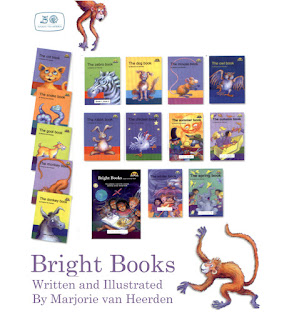In January 1989 her husband, Johann, decided to leave academia and he
accepted a position as a film and television producer and the Van Heerdens
moved to Johannesburg. In 1991 he joined M-Net, a Pay-TV service, as an executive.
In Johannesburg, Penguin (SA) approached Marjorie with the offer to head their
children's books section. She agreed to do this for one year.
Marjorie was a committee member of the Johannesburg Children's Book Group until
1994, and was involved in organising a children's book festival in Johannesburg
in October 1989 - this subsequently became an annual event.
She also served on the steering committee forming a new Johannesburg Children's
Book Forum to focus on the needs of the New South Africa after democratisation
in 1994.

For more than forty years Marjorie has been building up her large specialist library and researching the field of children’s literature, particularly for beginner readers.
 |
| Marjorie's home studio in Linden, Johannesburg. |
She has been very active in promoting children's books by
writing articles for specialist publications and giving talks, lectures and
workshops to audiences ranging from small groups of parents to large gatherings
of teachers, librarians, university lecturers and other specialists in the
field. Her main focus was to help address and support developments in the new
democratic South Africa with specific reference to promoting child and adult
literacy amongst the historically disadvantaged communities.
Besides her own writing, Marjorie van Heerden has illustrated the books of
several other children's book authors, has illustrated many school readers and
has written and illustrated for various children's magazines.
She has published
a number of articles on children's books - all in South Africa. At this time her books have
been published in many African countries and some have been translated into English,
French, German and about twenty African languages.
Marjorie was co-author and the illustrator of Baba's Plan (1990), the first book to be published as
result of a conference organised by Sue Hepker, then of
The Read 
From 1990 to 1996 she compiled (and often illustrated) four pages for children in the monthly Edgars Club Magazine, which had a circulation of over one million - the largest in South Africa.

These fully illustrated books are designed for distribution amongst pre-schoolers and beginner readers in the very poorest communities. Twenty-one titles in this series have already been published by the Ntataise Trust. Marjorie wrote and illustrated all these readers.
These twenty-one titles became the first picture books personally owned by thousands of youngsters. The master copies spread quickly… A colleague of Marjorie's even saw copies of these little self-made books in Nigeria, more than halfway across the African continent!
These A4 “master pages” were distributed across the rural areas in South Africa. The local doctor or police chief or post mistress was persuaded to make available their photocopier to Xerox a free copy for each kid in the class.

In 1997 Nasou Publishers developed and published the whole series in a full-colour version, called the “Bright Books Series”, all conceptualised, written and illustrated by Marjorie van Heerden; the first set of 11 books, containing 36 original stories aimed at Grade One learners was published in 1997. From this developed a second set, four books for Grade Two learners, published in 1998 and a third for Grade Three learners, published in 1999, all written and illustrated by Marjorie. These sets of readers for early learners were scientifically developed to suit the specific cultural and educational needs of the youth of the new democratic South Africa and they cover the Foundation Phase of the new South African school system.
In July 1995 Marjorie received a
scholarship to attend the Highlights
Foundation Writers’
Workshop Symposium at Chautauqua in New York State, USA. Ed Young was her mentor during the Symposium. After her return to
Africa she started developing a completely new technique of illustration, which
she first used in The Zebra and the
Baboon, written by Thomas A. Nevin and published by Garamond Publishers
in 1996.
The original artwork for a number of her books has been shown at various international exhibitions in Europe and elsewhere, including the acclaimed travelling Exhibition Amabhukhu, organised by La Joie par les Livres and opening at the 1999 Bologna International Children’s Book Fair in Italy. Subsequently the exhibition was shown in Canada and in various European capitals. The illustrations for her book Monde’s Present were chosen for this exhibition, together with work from 34 other artists from Africa.
In 1998 Marjorie wrote and illustrated three books for Cambridge University Press for their Cambridge Reading Routes Reading Programme. Subsequently she was asked to art direct the contributions from the other eleven South African writers and illustrators.










